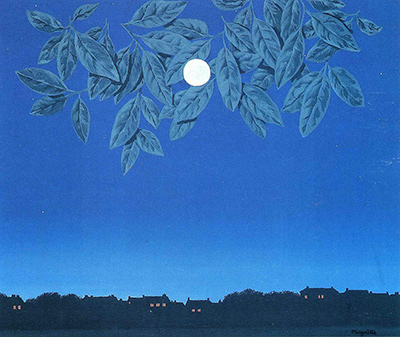The White Page (La Page Blanche) is an oil on canvas painting by Rene Magritte, a surrealist painter, who along with his fellow surrealists produced artworks that played with reality and illusion.
Following traditional oil painting techniques, the subject would have been sketched onto the canvas, often with charcoal, then paint was transferred to the canvas using paintbrushes, palette knives or sometimes rags. Forever associated with pipes and bowler hats, which feature in many of his works, Magritte’s thought-provoking images challenge our perception of reality. By positioning ordinary objects in an unusual context, such as a host of bowler-hatted men suspended in space above a landscape as if they were rain (Golconda, 1953), Magritte’s works have inspired and influenced many contemporary artists such as Storm Thorgerson and Andy Warhol.
One of his most famous quotes ‘visible things always hide other visible things’, is perhaps no better illustrated than in this painting. The White Page features a night sky and a city landscape and nowhere is there any visible white. The ‘white page’ could be said to be ‘hiding’ beneath the painting perhaps. The White Page was the last of Magritte’s paintings, completed in 1967, shortly before he lost his battle with pancreatic cancer on 15th August of that year. In the painting, a yellow circle has been placed strategically in the upper middle of the composition. At first glance it is a full moon, yet look again and it appears in front of the tree branches, almost like a plump fruit. This was Magritte’s skill, creating an object with dual identities to skew the viewers perception.
At the bottom of the composition is the city landscape. The predominantly blue background of the image evokes a sense of calm. René commented on his artwork: "If we were to see leaves behind the moon, it would be extraordinary, life would finally be meaningful". The title of the painting is often accredited as a tribute to Stéphane Mallarmé's obsession with the white page. (Mallarmé was a French poet in the late 19th century who held a fear of the white page – to him it evoked uncertainty, a fear of the failure of communication).
This painting, along with some 200 other original Magritte paintings, is housed in The Magritte Museum which opened in 2009 in Brussels. Most of the work is directly from the collection of the artist's widow, Georgette Magritte, and from Irène Hamoir Scutenaire who was his primary collector.




